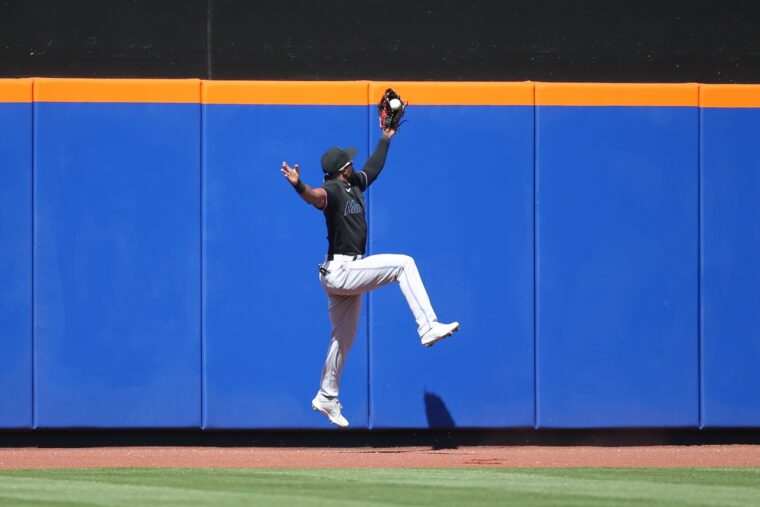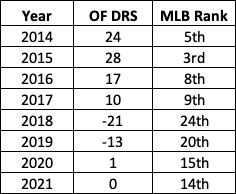
Brad Penner-USA TODAY Sports
Over the span of a few hours on Black Friday last November, the New York Mets completely remade their outfield by signing Mark Canha and Starling Marte to join Brandon Nimmo. And, as it turns out, they may not be done supplementing to this part of the roster once the lockout ends sometime this century.
With all the innings he’s logged in center field, it was easy to assume Marte would man that position and push Nimmo to a corner spot. I thought it was interesting that Nimmo — who recently hired Scott Boras to be his agent — came out and said quite plainly he’d like to stay in center this upcoming season. As our own Patrick Glynn pointed out when this news dropped, Nimmo has a point, too.
If we only look at what happened in 2021, advanced defensive metrics favor the Mets’ incumbent center fielder over the one just joining the party. Nimmo entered 2021 with a career Defensive Runs Saved (DRS) of -12 in center field before producing a +4 mark through his most recent 678 2/3 innings played there. As for Marte, he’s been worth -12 DRS over the past three seasons, with a -4 mark through 1,022 2/3 frames in 2021. Statcast’s Outs Above Average (OAA) metric has the race between these two a little closer, as Nimmo was worth 4 OAA last year, while Marte checked in with 2.
Marte was actually much better in left field during the earlier portion of his career, winning back-to-back Gold Gloves for the Pittsburgh Pirates in 2015 and 2016. We’ll eventually see what defensive alignment the Mets will go with for their outfield this season, but it certainly feels like this area of the roster has been strengthened quite a bit. When thinking about this, I was curious as to how the cumulative outfield defense has performed, according to advanced metrics, in recent years. All I have to say is my goodness, it’s been an absolute roller coaster ride. Thankfully, it appears New York has gotten past the low point. At least, we can hope so.
Here’s a quick look at how the Mets’ cumulative DRS in the outfield has looked since 2014, which was when the organization last had a Gold Glove winner in Juan Lagares.

Talk about opposite ends of the spectrum, right? Three straight years within the top-10, followed by two straight years in the bottom 10. It was encouraging to see such a shift from 2019 to 2020, but we also needed to take it with a grain of salt because the latter was such a shortened campaign. So, that’s why it was even more encouraging to see those improvements hold steady over a typical 162-game schedule in 2021.
Obviously, the Mets’ overall defense took a huge step forward in multiple areas last season. Part of that was because a Gold Glove-caliber fielder in Francisco Lindor was added to the mix, but also because New York just started shifting and positioning its fielders more often and more effectively.
The Mets posted 48 DRS as a squad in 2021, which was among the top-10 in baseball. To put this number in perspective, they produced -21 DRS in 2020 and -44 in 2019. What’s interesting here is how the Mets’ rate of shifting has changed over this period of time — it was 14.1% in 2019 (28th in MLB), 21.4% in 2020 (27th in MLB), and 50.2% in 2021 (second in MLB).
Assistant General Manager, Ben Zauzmer, brought this change when he arrived from the Los Angeles Dodgers before the 2021 season, and it’s paid off. With more natural outfielders on the roster and in the everyday lineup, we can hope this positive shift in production can continue into 2022.
Although Nimmo is a team player, it’s clear as to why he’d like to stay in center field. Not only has he shown progress in recent years at the position, but it also makes him a much more valuable commodity on the free-agent market (especially if he pairs it with a fully healthy season). For a club like the Mets, one that has been centered around the starting staff for the better part of the past decade, improving the performance floor of the defense is important. It’ll obviously help maximize the starts made by Jacob deGrom and Max Scherzer, but also for the rest of the rotation, which has some question marks at the moment.
So, I don’t necessarily think the eventual alignment is going to be all that crucial. Since they used analytics effectively to improve the team’s defense last year, they’ll continue to lean on the numbers to make informed decisions on who will play which position. As we saw with Nimmo playing a deeper center field in 2021 (and it working well), I’ll be more interested in seeing where the Mets position the players to maximize their production on a consistent basis.
















